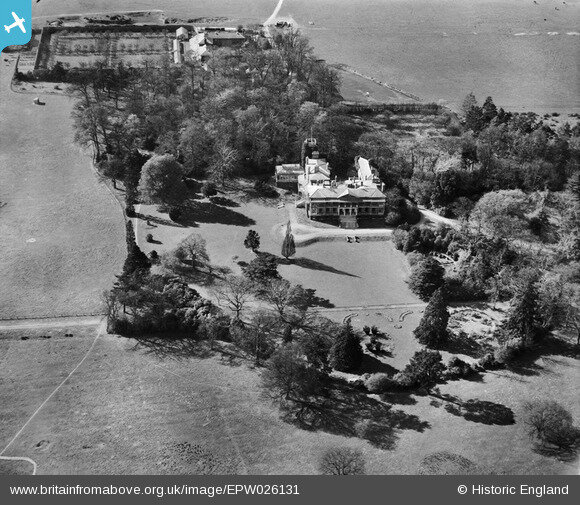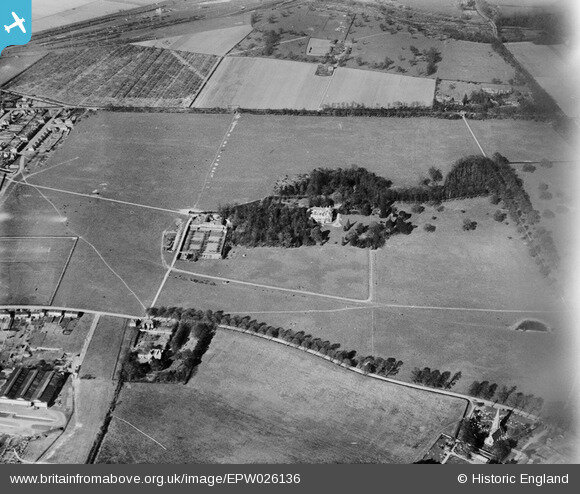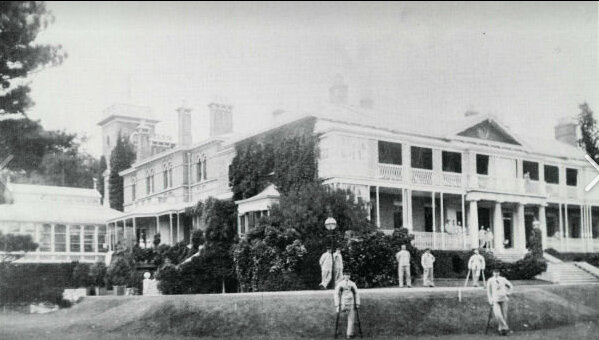HPH History
Hanworth Park House dates back to around 1802—although additional wings and clock tower added some years later. It was built on the grounds of Hanworth Park, which was formerly a Royal park, where Henry VIII and later Elizabeth I (who lived for a time at the nearby Hanworth Manor, located next to St George’s Church) loved to hunt.
British Red Cross Hospital 1917
Hanworth Park House has had a wide range of uses over the past 200 years, ranging from luxury residences of both the Perkins family—who built it, and had one of the most incredible private libraries — to MP Alfred Lafone and his family of 9 children. Upon his death, the house was used by the Red Cross as a hospital during the first World War (WWI 1914-1918), while bi-planes built at the nearby Feltham factories would take off from the park, the Longford River having been put into a culvert.
During the 1920s through to mid 1930s, the Airpark was home to the National Flying Services’ headquarters, which hosted notable periods of aviation history, including the King’s Cup in 1930, two landings of the famous Graf Zeppelin, and Amelia Earhart’s arrival in London after successfully crossing the Atlantic solo.
1932
Tens of thousands of people turned out to see the Graf Zeppelin in 1931 and 1932. Due to its size, it had to be tethered down to the airpark, including by groups of local boy scouts. (Photo credit: Pathe News)
1940s and 1950s
In the 1940s, the old aircraft hangers around Hanworth Park House were bought by David Brown who produced Aston Martin’s now iconic sports cars at the site. This included the racing team who won Le Mans. Aston Martin vacated the airpark in the early 1960s relocating to Newport Pagnell. During the early 1950s, the house was used as a Hotel—’Hanworth Park Hotel’, before being sold on to what was then Middlesex County Council 1992.
From Hotel to Care Home
In 1956, the hotel was then converted to be used as a local nursing home through to 1992. At that point the Council, now controlled by the London Borough of Hounslow closed the nursing home, and sold the house off for use as a hotel and conference centre. Unfortunately, even though the hotel plans were approved the refurbishment never materialised, and the building has had several owners and proposed developments until the bought by the current owner Gary Cottle in December 2014.
Hanworth Park House Timeline
2017 till present, The friends of Hanworth Park House and History team are created.
2014 Gary Cottle the present owner plans to save the house from hotel consent, to enabling development and create a large community hub with housing.
1992 till 2014 various buyers try to save the site with hotel plans but never happened.
1992 Nursing home closed – various buyers until Gary Cottle
purchases Hanworth Park House.
1950s The House become a nursing home – the aerodrome becomes
local amenity park: Hanworth Air Park.
1947 Hanworth ceases to operate as an aerodrome – hotel still
operating.
1940 No.5 Elementary and Reserve Flying Training School at Hanworth moved to Meir, Stoke on Trent - see 1935 below.
1939-1945 Hanworth received planes for repair through the
Civilian Repair Organisation – ferried by Air Transport Auxiliary.
1937 Tipsy Aircraft Company Ltd manufacture Tipsy Aircraft at
Hanworth.
1936 Amy Johnson attends a garden party at Hanworth, where
she christens an air ambulance ‘Florence Nightingale’.
1936 Clem Sohn delights audiences at Hanworth – he jumped
from airplanes in a winged suit.
1936 Charles Lindbergh visited Hanworth- it was his first
flight in England after receiving his pilot's licence.
1935 Blackburn Aircraft Ltd and the London Air [Flying] Syndicate set up a new company: Flying Training Ltd to operate No. 5 Elementary and Reserve Flying Training School at Hanworth. Read all about No 5 here: https://tinyurl.com/y763vezh
1935 General Aircraft moved to Hanworth.
1935 National Flying Syndicate refurbished the house:
Hanworth Park Hotel – hoping it becomes the: ‘Ascot of Aviation’.
1935 British Klemm Aeroplane Ltd taken over by British
Aircraft Manufacturing Ltd.
1934 National Flying Services ceased trading.
1933 British Klemm Aeroplane Co. Ltd established at Hanworth.
1932 Zeppelin at Hanworth.
1932 Cierva Autogyro Co manufacturing and Autogyro Flying
School established at Hanworth.
1931 Zeppelin at Hanworth.
1929 National Flying Services bought Hanworth Park House and
land.
1926 Aston Martin established at Feltham/Hanworth.
1920 Whitehead declared bankrupt.
1917 Whitehead diverted and culverted the Longford River.
1916 John Whitehead built aircraft factories at Hanworth.
1915-1918 The house was home to the Middlesex Auxiliary Hospital, run by the Red Cross.
1873-1915 The house was owned by Alfred Lafone.
1828-1872 The house was owned by Henry Perkins followed by his son Algernon Perkins. [Research ongoing]
Source documents detailing the building of Hanworth Park
House and the architect are yet to be found. [Feb 2020]
Credit Katy Cox BA (Hons)















